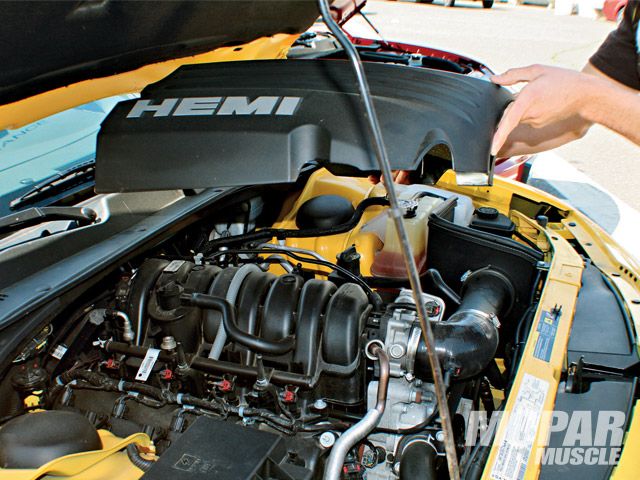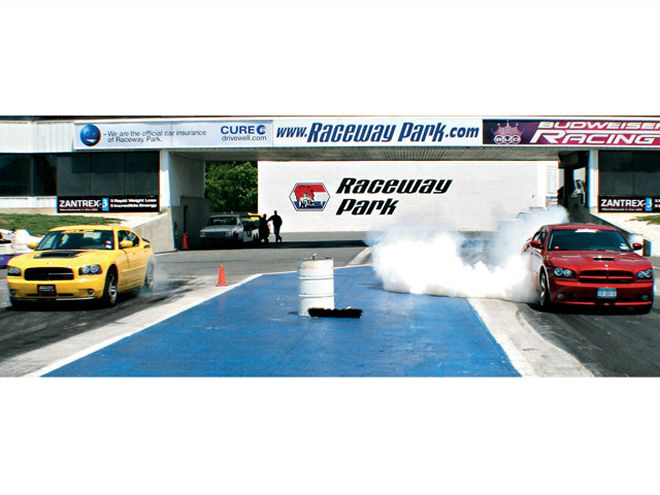
 We were back at SLP so we could further flog their latest go-fast goodies available for the late-model Hemi (Charger, 300C, and Magnum). Ed Hamberger's SLP crew used their Charger Daytona mule and a willing friend's (Eddie Perez) SRT8 to design, test, and manufacture their latest performance products.
We were back at SLP so we could further flog their latest go-fast goodies available for the late-model Hemi (Charger, 300C, and Magnum). Ed Hamberger's SLP crew used their Charger Daytona mule and a willing friend's (Eddie Perez) SRT8 to design, test, and manufacture their latest performance products.
Once again we were back to resume testing of more of SLP's recently developed products for the new Hemi. Rewinding to the April 2007 issue article "Happenin' Hemi Headers," SLP's headers and exhaust yielded an additional 21 rwhp and 31 lb/ft of torque of the factory system. The important average gains from 3,000 to 5,000 rpm were 33 rwhp and 30 lb/ft of torque. At the track, this equated to a drastic half-second reduction in e.t. This really caught our attention--these late-great Hemis really respond to the old-school upgrades.
After that test of the headers and exhaust, SLP developed a Cold-Air Induction Package, Power Programmer, and an Underdrive Balancer/Pulley. The first product they designed, tested, and manufactured for production was the Cold-Air Induction Package. It replaces the stock restrictive air box assembly. This high-airflow, power-enhancing system proved to be worth 7 rwhp on the SuperFlow chassis dyno. That amount of power improvement is worth an easy tenth at the track.
Next, SLP and DiabloSport spent time collaborating to co-develop the handheld tuner/power programmer. All of their R&D work paid off and enabled the power programmer to be worth 12 rwhp and 11 lb/ft of torque. The SLP/DiabloSport programmer has performance tunes specific for their 5.7 and 6.1 Hemi PerformancePacs. These handheld devices can perform multiple custom tunes, transmission shift points/firmness, vehicle speed and engine rev limits, cooling fan speed/temperature adjustments, along with all the many DiabloSport tuner features. Most owners of bone stock, late-model Hemis want to remove the conservative (and usually pig-rich) factory tuning for a more aggressive tune suitable to their high-performance taste.
Another effective bolt-on for gaining power is an underdrive crankshaft pulley. The Third-Gen Hemi utilizes a one-piece balancer/pulley assembly, and SLP recently began offering a high quality, SFI approved unit that adds 9 hp and 10 lb/ft of torque to the rear tires. Having road- and strip-tested SLP's Daytona before and after the balancer/pulley swap, the Hemi feels as smooth, if not smoother, than ever. In addition to a performance gain due to less rotational drag, an underdrive pulley means better fuel economy and longer accessory (alternator, a/c compressor, p/s and water pump, tensioner pulley) life.
Adding the total power gains of 28 rwhp from the three new power producers made us anxious to get back to our favorite test track, Raceway Park, E-Town (Englishtown, NJ). The day before our track date, SLP's Hank Danieki, chief engineer, asked if we could possibly test customer Eddie Perez's SRT8 Charger. We said sure as long as it was the car we spied them installing their headers, exhaust, and cold-air induction on. Hank assured us it was indeed that car.
While driving SLP's Daytona mule-car to the strip (a one-hour ride) we tried different tunes and automatic shift points and firmness. Man, what these handheld tuners can do in minutes would take many knuckle-busting hours to do on our old Mopars. At the track, we achieved our lowest e.t.'s using the tuner's best performance tune along with 6,000-rpm shift points. For the 6.1 Hemi, we found 6,400-rpm upshifts to be ideal.
Both Hemi cars have their differences when trying to launch out of the hole. The Daytona can be punched off-the-line, but for big brother SRT8, it's not an easy task on stock tires. Eddie, who had drag raced his Charger the previous weekend, was having traction issues. The best hook and 60-ft e.t. came by precisely-timed go-pedal depression. It had to be slightly slower than when stomping the pedal of the Daytona. On the scales, the SRT8 weighed nearly 200 pounds heavier than the Daytona (4,440 vs. 4,250 pounds). The 6.1 has a cast-iron block while the 5.7 is aluminum alloy. Beefier sway bars, wheel, and tires also explain the added poundage of the SRT8.
Weather conditions on our test day were definitely not conductive for low e.t.'s. A barometer of 29.41 hg (an approaching storm came later in the day) along with high humidity worked against us on this 75-degree day. We're sure the atmosphere cost us a tenth or two compared to a good-air day. Bone stock 5.7 and 6.1 LX cars will usually run (on the average) 14.4 at 96 and 13.5 at 105 mph respectively. Still, on this bad-air day the Daytona showed us a best of 13.57 at 102.55, while the SRT8 managed an impressive 12.88 at 108.96 mph.
Naturally, we feel that if we'd used sticky meats, low 13's and mid 12's would have been possible for these two SLP-tuned runners. Nonetheless, we received impressive numbers from just a few simple upgrades. By the time you read this, the same goodies (plus a few more) should be available from SLP for the new Challenger.
Strip Test Results
2006 5.7 Hemi Charger
Temp: 86 Degrees; Humidity: 54 Percent; Barometer: 29.97 Hg
Run/TempMods60-FT1/8 MPH1/4 MPH1/74cold-air, pulley, programmer2.058.75/81.2313.60/102.102/74hot lap2.048.71/81.2613.57/102.553/751-hr cool-down2.058.75/80.6113.63/102.514/75hot lap2.058.74/81.0013.59/102.515/753rd hot lap2.058.74/81.0113.59/102.50